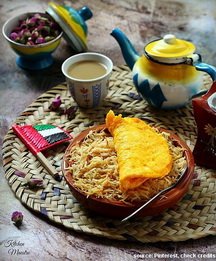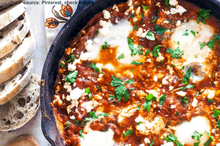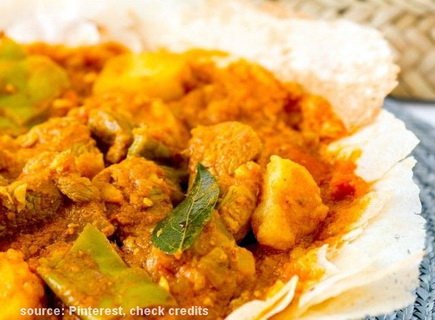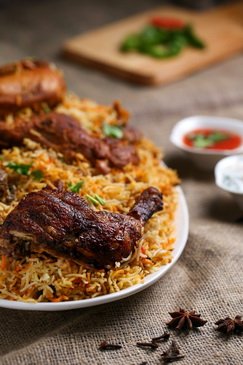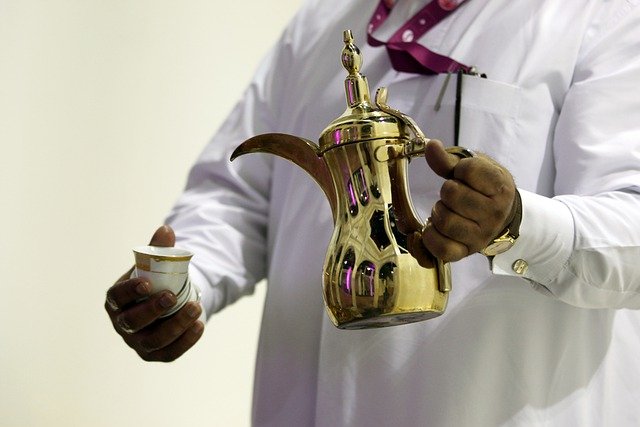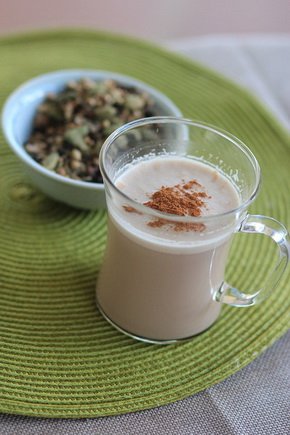To eat or not to eat… good question
What food should you try in Dubai
To eat or not to eat… what’s the answer?
What for breakfast? Balaleat – Baith Thamath – Chebab – Madrouba – Manakish – Thareed – Arab Bread – Street food – Main dish – Kabsa/Machboos – Ghuzi – Harees – Salads: tabbouleh & fattoush – Sweets: Lukaimat – Khanafaroosh – Drinks: Ghawa – Others
T
here is no better place than Dubai to savor the tastes from all around the world. All the nations are invited, so it is just suiting that they feel at home there. And there is no better way to feel at home than to eat something from there.
But Dubai is a part of the UAE -the Emirati culture that grew on a wonderful heritage. In its core the cuisine here is multinational… and because of the history part – truly timeless.
You can read in the brief history part that the region was forever settled by the Arabs – the Nomads that turned into the Bedouins of today. There were European merchants and visitors here. In the more recent history – quite a big Persian population. Today – plenty of Hindi people, coming to Dubai to earn more than in India.
Except for the nations, there are the traditions of the region and of the seasons. Cooler months were the months of vegetables and rice. When it became too hot the meat was the only thing that did not spoil too fast. Being situated at the coast – the fruits of the sea were a natural solution when the lamb could not be killed yet. The dates brought the sweetness and energy needed when the sun stole everything from the body. The spices, sold and re-sold on the souks, gave the alertness, joy, and colors in between the dunes.
Naturally, it is impossible to describe each worth-eating dish from Dubai. But if you mix all the above together – you get the favorite meals of Dubai and the Emirati. You also get the traditional ones – eaten today out of the sentiment, curiosity, and returning to the cuisine as the heritage of the region. But be aware that many traditional Emirati dishes are simply cooked at home – it is only now that they are becoming a part of the tourist world.
 TIP! most of the main dishes come quite spicy. The Arabs and Hindi taste buds are used to it, but it can be a surprise for Westerners. We think we like it hot, and then we come to the Arabian Peninsula… Be aware of that and ask the waiter for advice.
TIP! most of the main dishes come quite spicy. The Arabs and Hindi taste buds are used to it, but it can be a surprise for Westerners. We think we like it hot, and then we come to the Arabian Peninsula… Be aware of that and ask the waiter for advice.
Breakfast
Because of the regional characteristics, even the first meal of the day had to be very satisfying. All the energy for the body came from eggs, meat, and sweets combined with bread, pasta, or grains. But the dishes come in different shapes than in the West.
Balaleat
Origin: Arabian Peninsula, Persian Gulf
Other spelling: balaleet
Recipe link
This hearty meal is a mixture of vermicelli and egg. You get it in different forms but the most common one is with an omelet on top of pasta. It comes with various spices making it even tastier than you would have thought this simple dish can be. Cardamom and saffron play the main part, they are accompanied by some sweetness from sugar or rosewater, with the salty finish of an egg.
Baith Thamath
Origin: Arabian Penisula, Maghreb (hot version)
Other spelling: baid thamat, shakshouka, chakchouka
Recipe link
Who doesn’t like scrambled eggs? The simple on or the artistic one – when you throw everything you have in the fridge into it. Even in an aubergine-onion goulash, it tastes wonderful. Here in Dubai or rather Arab states you find something similar, yet completely different. Bait tomat is a mixture of tomatoes and eggs prepared in a more solid or a watery (even soup in some countries) way. The other name for this breakfast dish is the Eggs in Purgatory – it is not often because usually, cumin comes as the main ingredient, but it can be a hot version. Just try it once and you will start making it at home every weekend!
Chebab
Origin: Arabian Penisula
Other spelling: chabab
Recipe link
When it is flat and fluffy and sweet it must be a pancake. And so, in Dubai, you will have a local version of it spiced with cardamom and saffron for an added edge (which are very typical additions in sweet recipes). Sometimes you will find some fennel or turmeric inside as well.
It goes well with dates syrup or yogurt or sour cream cheese inside.
Madrouba
Origin: Arabian Peninsula, Oman maybe (this version is very popular)
Other spelling: —
Recipe link
There exists no country without a porridge of some kind. Dubai is not an exception. This one is prepared from overcooked rice with meat or vegan – depending on the tastes. Every Arabian country has its own version and in India, you have a version of it called khichdi (added lentil).
Madrouba takes a long time to prepare and you have to mix it with a wooden spoon for obvious reasons. I write “wooden” because the name of the dish comes from the spoon used to beat all the ingredients together. It is eaten in Ramadan quite often, but you can find it in some restaurants in Dubai. The rice&chicken version is the most popular, but it comes in different forms as well. You can put all sorts of vegetables inside as well. It is heavily spiced with turmeric, cumin, cardamom, ginger, cloves, cinnamon, garlic, and black pepper.
This is a delicious version of your plain oatmeal or a very original one-pot recipe.
Manakish
Origin: Levant countries
Other spelling: manaquish, manaeesh, manakeesh, manousheh (singular!)
Recipe link
It is difficult to say whether you eat it for breakfast, or it is some sort of street food. What you need to know is that it comes in different shapes and sizes, so a small dose of mankish can be eaten/grabbed for a quick breakfast or a full-sized can be enjoyed on its own on lunch.
Imagine yourselves a pizza dough topped with spices or cheese or meat only. When it is baked cut it to slices or fold it and voila! You have a typical Dubai experience before you.
The most popular is the zaatar mankish – “zaatar” being a single word for a blend of spices used to top it (thyme, roasted sesame seeds, sumac – other spices added depends on the region).
Thareed
Origin: Levant countries
Other spelling: tharid, tashreeb, taghrib
Recipe link
The broth on bread would never taste the same after trying this dish. The secret lies in the typical Arabian flatbread that even soaked with broth is still fluffy and crunchy.
The legend says that this was one of the favorite dishes of the prophet Mohammed and thus it is mostly eaten during Ramadan.
The broth is made from vegetables or slow-cooked meat of different kinds (lamb, goat, and chicken are most popular). Roasted veggies add a special taste to it. There are plenty of tomato juices, sometimes some beans and spices.
It can come layered or with pieces of bread sticking out and waiting to be grabbed by someone. The devil is in this soaked bread full of tastes mixed in a symphony.
It is juicy, heartening, and delicious and it is very difficult to understand why it is a breakfast meal. Maybe because of all this bread. It is difficult to recreate at home, especially in a different than Arab country. Some things are just ought to be tried in the real environment.
This chapter wouldn’t be complete without adding fatteh to the mix. The idea is the same (also Levantine) but the stew is a mix of chickpeas, yogurt, garlic, and lemon. It can be vegan or with chicken. You can eat it like thareed or like a salat with toast instead of a flatbread. It is absolutely delicious, refreshing, and not heavily spiced.
Bread
Forget about your favorite loaves of bread. All the Arabian versions come as a flatbread. Because of the cultural variety, you have different names for them. You use a specific kind of bread for a specific recipe that it will be accompanying. And… last but not least, you have recipes for dishes/mainly fast food that circle around this freshly baked, flat piece of heaven.
Being said you have the names like khubz or khameer which are the most Emirati-close. You have paper-thin rigag that makes French crepes look like a heavy pancake. You have Levantine taboon or Iranian sangak. Pick your poison… – as they say. They all are a mixture of flour, yeast, and water with/without milk or spices. Another synonym is a pita bread – and that should tell you volumes.
But there is some magic in this bread. You should always eat it freshly baked! It sometimes happens that after a few minutes it becomes gooey – this is a signal that it is no longer good (but somehow it still tastes great!). But thankfully it is also something that is replenished often by the servers.
It can become its own dish like a pizza-like manakish or rigag-crepes bought from a street-seller. They are also part of many dishes and obligatory accompaniment to many.
Street food, lunches, bites, mezze=appetizers
Let’s be honest – being in Dubai means that you are in meat heaven. The street-food way is usually to grill it, but in the restaurant, you will find one other way. It is said to derive from Yemen – mandi meat is cooked in a pit receiving a special flavor because of that and being unimaginably tender.
On the streets of Dubai, you will find fast-food known by many as a kebab. But here it is in a shape we know as shish kebab – meat on a stick (ground or cubes). There is also taouk – chicken breasts on a stick. Finally – shawarma – with rice, French fries, or wrapped in a flatbread.
All are equally delicious, well-spiced, often spicy. You receive it in/with local bread, with rice (Persian chelo – thus chelo kebab sometimes) or fries. There are some vegetables raw or in the form of a salad.
Rigag bread comes in a triangle form, crispy and yummy. From street-sellers, you can buy it with egg, cream cheese, and a special fish sauce inside. There apparently is also a version with potato chips. They say you have to try it with a local salted yogurt – Laban milk.
Hummus
is another local favorite. Given as an appetizer with veggies or bread. Plain or spiced. If you think that you do not like hummus – give it a try in here. It may change your life forever. Veggies often come with labneh as well. It is a simple (or not) sour cream cheese. Sometimes coming with olive oil, mint, or lemon. It can be a refreshing dip or an addition to other snacks and meals.
Foreign influence comes in the form of a well-known falafel. Another one is samboosa/samosa. Just follow your nose to these tasty triangles, when you walk the streets of old town souks. Filled with meat or veggies or some other filling they are as tasty as in their home – India.
Main dish
Rice and meat are the basis of the local diet. Rice is usually spiced, although it sometimes comes in plain form. Meat takes a long time to prepare. It is made in the traditional, Yemeni way – in the pit (mandi) or various others. The final product comes out so tender, that you cannot even take it into your hands without it falling apart. Depending on spices or the region it came from the dishes get different names.
Traditionally it was served in a central plater, during a meal eaten on the floor. You scooped a bit of everything with your hands and ate. Eating and serving were preferred with the right hand (the left one being unholy).
Today grilled food is also very popular. Be it meat, fish, or vegetables. Accompanied by a fresh salad or veggies – the meal feels very light. It is like having a barbecue all the time.
Meat used in Emirati cuisine is the same as it was before. The most loved is the lamb – being the main red meat of the country. Beef is more western, but you can find it in some places. These kinds of meat require long, slow cooking or roasting/grilling. It is sometimes put into pits or wrapped into leaves to keep most of the flavors inside. Chicken is the second favorite – being quick to make and easily accessible. Other kinds and poultry are accessible too, of course.
But what is appearing more and more recently is the camel meat. Whiter than red meats but still in the same family – they make all the favorite dishes with it. Camel burgers are very popular among tourists and the whole idea fits well into this industry. However, for many, it is like eating a horse – or any other hard-working animal living next to a human for thousands of years.
Kabsa/Machboos
Origin: Persian Gulf countries
Other spelling: machbous, majbus, kabsa, kabseh
Recipe link
The name variation is because of the origins of the dish. Kabsa is said to come from Saudi Arabia, machbous – from Bahrain. But the variations of the dish were prepared at the Arab Peninsula for ages. As the Emirati say it – they cook as their mother did, who learned it from her mother and so on.
Basically it is meat over rice. Meat can be boiled, fried, or made in the mandi way. It has to give some juice at the beginning. Then the spices are mixed into it – as you wish or Baharat – nutmeg, cinnamon, cardamom, and bay leaves are quite important. But the biggest challenge for a western cook comes in getting the loomi – the base is dried ripe lime.
You combine the tastes, add rice – so it takes in the spicy stock, and add the meat. It all stays together for some time to become THE DISH.
Ghuzi
Origin: Persian Gulf countries
Other spelling: khuzi, oozie, quzie, sometimes shuwaa
Recipe link
Depending on the country there are many ways to prepare this savory meal. In the most popular traditions, the meat is stuffed with rice (Iraq), or the whole thing is wrapped in palm leaves and then baked in an oven or a pit (Saudi Arabia).
It may sound like the dish above. The difference may come in preparation – the original recipe was made by stuffing the lamb. There is no loomi, and you can find inside some nuts and raisins.
Feel free to taste both in Dubai – they are equally delicious. You may also be surprised by the combinations of both. Emirati national cuisine is young – accustoming itself to the tourist needs. But more and more chefs are appearing, changing and mixing the recipes and making the old dishes in a completely new way.
Harees
Origin: in the legend – mountains of Kurd, then all Saudi Arabia
Other spelling: jaresh, Haleem (with chicken)
Recipe link
Today it is a traditional Ramadan food. Plain and simple it was very satisfying and easy to make in ancient times. Wheat and meat mixed – nothing fancy, just something to fill your belly.
The idea was to overcook everything – this way the wheat became a porridge and the mutton meat disintegrated in the mix. With some spices it became delicious. The long process gave it the gooey consistency.
It doesn’t look as much, but there is a dish like that in every country. The famine and necessity were what made them. After long days of absence or being eaten in the shadows of a traditional household, it came back into view. Today you pay a fortune for it (snails in France have the same history) or just enough. The chefs make it beautiful, with colorful toppings or caramelized onions being a crown on top of a bowl of pudding.
Appreciate it in small quantities. It is good but will make you full quickly. Try not to think about hungry pilgrims or soldiers of old, receiving a bowl like that as a welcome. Or maybe do think about it – it is not only taste but also a story behind the dish that makes it special.
Salads
Although a lot of the above dishes have meat inside, they evolve with the need of people. We are no longer Nomads, needing strength for the upcoming day. We no longer eat just one meal that has to sustain us. Thus, a lot evolves to become meat-free, with only vegetables inside.
There are also salads – not the ones we know but more Levantine.
Tabbouleh (photo – top one) can be a dish in itself. It is a mix of fresh veggies and bulgur wheat. It is very refreshing because of fresh mint and lemon juice added to the mix. A surprise comes in the form of small, rose dots which are the grains of the grenade.
It is simply beautiful and very healthy thanks to the abundance of green parsley. If you like tomatoes and onions but want something more – you should definitely try it in Dubai or make it at home.
Fattoush (photo – bottom one) is another hit. Made with crumbs (fatteh in Arabic) of flatbread as the main ingredient. You can easily make it with any fresh vegetable you have at home. The traditional version is with mixed greens, radishes, and tomatoes. The dressing should have inside garlic, lemon, and mint. Other than all this there is no real rule to make this salad. Feel free to use your imagination or be inspired by some web recipes.
Sweets, drinks and then some…
Lukaimat
Origin: —
Other spelling: luqma, luqaimat, lokma (turquish)
Recipe link
Luqma meaning a morsel in Arabic perfectly reflects the idea. It is truly a small morsel of heaven.
It is impossible to trace the origins of this sweet. It was given as a treat to the Olympic contesters in Ancient Greece. It was in the Abbasid caliphate and is mentioned in 1001 Nights. In Poland, a bigger version is called “pączek” or you have small bites where the dough is mixed with Polish white cheese (twaróg).
There is nothing more beautiful than a small ball of dough, deep-fried, and put in front of you. It just begs to be touched! Garnish it with sugar, syrup, chocolate – mhmmmm…
In Dubai, you will get it with sticky date syrup and some sesame seeds on top. It is a Ramadan treat, or rather it was one. Now it is a favorite Emirati sweet eaten on various occasions. Just try to really eat a morsel of it – as it was intended by the name. And if you fail – just enjoy it!
Khanafaroosh
Origin: Persian Gulf countries
Other spelling: luqma, luqaimat, lokma (turquish)
Recipe link
Cardamom and saffron cake. Sounds as everywhere else, right. Yes – you can put the date syrup on top or mix it with a yogurt/sour cream cheese dip. And then your senses skyrocket through the roof.
It is a very easy Emirati sweet. I refer to it as to the mixture of a polish racuch or French madeleine cake. It can be flat, fluffy, or mini-wheel-like. The spices, so popular in Arab cuisines, add this special taste that you would never dream of. It can be called a soft teacake because it is best enjoyed with a cup of ghawa – local coffee.
Try it once and you will be surprised how it will change the way you bake at home. Suddenly you start adding cardamom to a carrot cake or saffron and cinnamon to pancakes.
All in all, it is a local experience to try them. And a very pleasant one if you have a huge sweet tooth.
Ghawa
Origin: Persian Gulf countries
Other spelling: qahwah
According to the legend, everything started with a shepherd and a goat. Somewhere in the Levant countries, an animal ate berries from a bush. When it returned home with its human something strange happened. The shepherd noticed that the goat is very aware and doesn’t want to sleep – which made his night very miserable.
But the curiosity won and the next day he returned to the same place. Walking around he found a bush and took the berries. It is always wise to be wary of the dangers. He made a brew out of the berries, tasted it, and experience the same symptoms as the goat. He felt a new force in his bones, he felt refreshed and very alert.
Sounds familiar?
Today we have a black brew we call a coffee but the Arabian version is clear or smoky in color. It is nothing you would normally expect from a coffee. I is prepared in a traditional way, served in a tall coffee pot. The brew goes through a long neck, is poured from a height into a small bowl. It loses some heat on its way so, and you get a tiny amount to drink so it is ready for your taste buds instantly. It is a must-have while in Dubai.
Others
There are many different dishes, mezze or sweets that await you. It is almost impossible to describe them all.
Karak chai is something that was brought from India or the tea countries. It is a sort of a terribly strong black tea with added milk. It serves as a coffee – refreshes nourishes and makes alert. You can get it as cheap as 1 AED in some places. You can also be sure that a steaming liquid in a paper cup is probably this thing. It is very popular.
Mehalabiya and knafeh are both sweets. Maybe not Emirati, but Arabian, and widely enjoyed in Dubai. The first is a sort of refreshing panna cotta on rosewater with some pistachios – less sweet than all the date spiced sweets you got used to. The former is a cake, made from vermicelli size dough, spiced, and sweetened with syrup. The cheese makes it gooey and nuts add the edge.
Enjoy!


